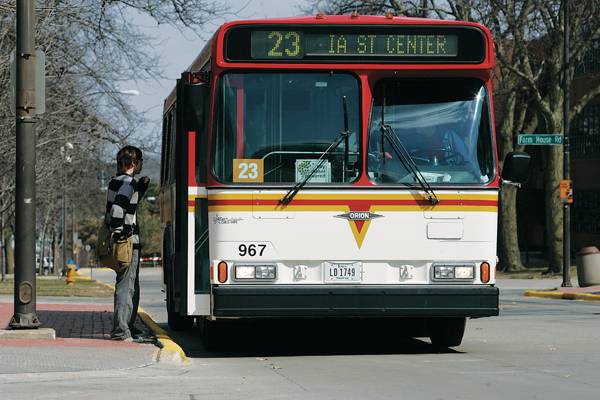CyRide receives extensive overhaul

The city of Ames capital improvement plan features more “aggressive” updates this year for the CyRide bus system as a result of a 27 percent ridership increase, said Sheri Kyras, CyRide director of transit.
February 7, 2010
The city of Ames capital improvement plan features more “aggressive” updates this year for the CyRide bus system as a result of a 27 percent ridership increase, said Sheri Kyras, CyRide director of transit. These updates are made possible by federal grant money, ISU monetary support and the city of Ames.
Each year, CyRide receives grant money from the federal government. This year CyRide received about $18.5 million that will be used over the next five years and fund seven expenditures. Proposed improvements would not be possible without federal aid, though the city of Ames will be funding a total of $3,661,238 and Iowa State will be funding a total of $800,000 from student fees over the next five years.
City manager Steve Schainker noted that the city’s proposal for the capital improvements plan was based on the amount of capital available.
“You have to decide how much money will be available this year to cover the capital improvements,” Schainker said.
In the case of the transit system, Schainker noted that the proposal was also based on how much federal and state funds are available to the city for the year, and the decision on what will be funded is based on need.
This year, CyRide has expressed a need for improvements on bus stops, vehicle replacements and expansion of CyRide headquarters, among other expenditures that are scheduled to receive maintenance between 2011–’15.
Kyras noted that the proposals for improvements were based on the improvements staff’s “need to implement in the next five years in order to efficiently operate CyRide.”
A few years ago, CyRide analyzed the bus stops both on and off campus to determine the need for improvements, including constructing concrete pads at the stops, setting up benches and shelters or lighting installation.
One criterion used to determine which bus stops will be revamped included “the number of riders boarding at that location,” Kyras said. “Another criteria was if there was any shelter nearby.”
The capital improvements plan also included plans to purchase new CyRide buses this year.
“CyRide has the 14th-oldest urban bus system in the nation,” Kyras said. “And we have over 800 transit systems around the nation.”
The federal funding CyRide received for the current capital improvements period will allow for the purchase of $2 million worth of new buses in 2010. CyRide depends on federal grants to fund 83 percent of these purchases.
Adding new buses to the fleet also poses issues for the streets in Ames. Included in the capital improvements plan is a proposal to rebuild a portion of various CyRide routes that have deteriorated over the years.
“Originally, CyRide had smaller buses that didn’t weigh as much and didn’t create as much wear and tear on the streets, and now we’ve transitioned to the larger vehicles which are heavier and do create more damage on the streets,” Kyras said.
John Joiner, director of public works, added that some of the older streets in Ames “weren’t designed for the buses.” Certain routes are deteriorating faster and need thicker pavement.
This year, starting in the spring after ISU students are dismissed for break, the city of Ames will pursue full replacement projects on Ontario Street, Ash Avenue and Knapp Street. The improvements will take 12–15 weeks. Joiner said the contractors are under a tight contract to complete the improvements before students begin to return for fall semester.
















